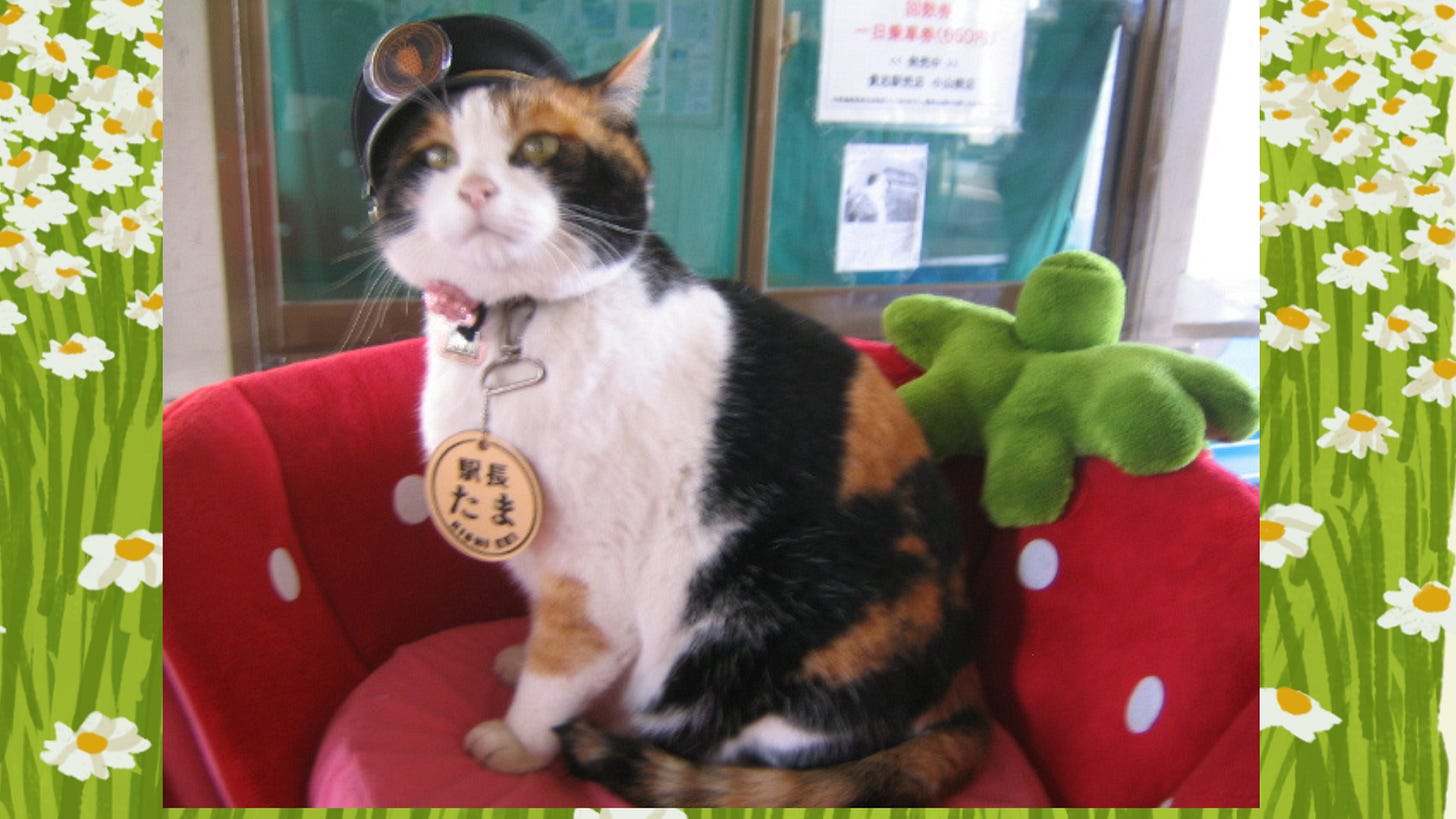A stray cat, a stationmaster, then a god
Japan's Most Famous Cat — With an Economic Impact of 1.1 Billion Yen

日本(にほん)にはアニメのキャラクターとして有名(ゆうめい)な猫(ねこ)はいます。しかし、たま駅長(えきちょう)は実在(じつざい)した猫(ねこ)では日本(にほん)で一番(いちばん)有名(ゆうめい)な猫(ねこ)かもしれません。
There are many famous cats in Japanese anime. But Tama the stationmaster might be the most famous real-life cat in Japan.
たま駅長(えきちょう)の誕生(たんじょう)
The Birth of Stationmaster Tama
たまは1999年(ねん)に和歌山県(わかやまけん)で生(う)まれた三毛猫(みけねこ)です。三毛猫(みけねこ)とは白(しろ)・黒(くろ)・茶(ちゃ)(オレンジ)の三色(さんしょく)の毛(け)の猫(ねこ)のことです。
Tama was born in 1999 in Wakayama Prefecture. A calico cat has three colors of fur: white, black, and orange.
南海電鉄(なんかいでんてつ)の貴志川線(きしがわせん)の貴志駅(きしえき)のとなりにお店(みせ)があり、その後(うし)ろに倉庫(そうこ)がありました。その倉庫(そうこ)にメスの野良猫(のらねこ)が住(す)み着(つ)いていました。その猫(ねこ)は飼(か)い猫(ねこ)ではありませんが、ミーコと呼(よ)ばれて、清掃作業員(せいそうさぎょういん)のおじさんが世話(せわ)をしていました。
Next to Kishi Station on the Nankai Electric Railway’s Kishigawa Line, there was a shop, and behind it, there was a warehouse. A female stray cat lived in the warehouse. She had no owner, but people called her Miiko, and a janitor took care of her.
ある日(ひ)、ミーコは4匹(ひき)の子猫(こねこ)を産(う)みました。そのうちの1匹(ぴき)が三毛猫(みけねこ)のたまでした。小山商店(こやましょうてん)はたまを気(き)に入(い)り、飼(か)うことにしました。しかし、お店(みせ)では食品(しょくひん)も売(う)っていたので、衛生(えいせい)の問題(もんだい)から、猫(ねこ)をお店(みせ)で飼(か)うことはできませんでした。お店(みせ)と倉庫(そうこ)の間(あいだ)に猫(ねこ)の小屋(こや)を作(つく)って、そこにミーコとたまは住(す)むことになりました。
One day, Miiko gave birth to four kittens. One of them was a calico cat named Tama. The people at Koyama Shop liked Tama and decided to take care of her. But because they sold food, they couldn’t keep a cat inside the store. So they built a small house for the cats between the shop and the warehouse. Miiko and Tama lived there.
ある日(ひ)、駅前(えきまえ)に子猫(こねこ)が1匹(ぴき)捨(す)てられていました。その猫(ねこ)は「ちび」と名付(なづ)けられました。ミーコ、たま、ちびは、よく貴志駅(きしえき)で遊(あそ)んでいて、駅(えき)の利用者(りようしゃ)たちにかわいがられていました。
One day, someone left a kitten in front of the station. That kitten was named Chibi. Miiko, Tama, and Chibi often played around Kishi Station and were loved by the people who used the station.
2004年(ねん)、南海電鉄(なんかいでんてつ)が、「貴志川線(きしがわせん)をなくす」と決(き)めました。近(ちか)くに住(す)んでいる人(ひと)たちは、貴志川線(きしがわせん)がなくなると困(こま)るので、なくさないでほしいと活動(かつどう)をしました。 その後(ご)、和歌山電鐵(わかやまでんてつ)という新(あたら)しい会社(かいしゃ)が、貴志川線(きしがわせん)を引(ひ)き継(つ)ぐことになりました。
In 2004, Nankai Electric Railway decided to close the Kishigawa Line. People who lived near the train line were worried. They started working to save the line. As a result, a new company named Wakayama Electric Railway decided to take over and run the Kishigawa Line.
市(し)の役所(やくしょ)の人(ひと)が、猫(ねこ)たちが住(す)んでいた小屋(こや)を見(み)つけました。その小屋(こや)は、市(し)の土地(とち)に許可(きょか)なく建(た)てられていたので、なくしてくださいと言(い)いました。
A city worker found the small house where some cats lived. The house was on city land without permission. The worker asked for the cat house to be removed.
和歌山電鐵(わかやまでんてつ)の小嶋光信社長(こじまみつのぶしゃちょう)が貴志駅(きしえき)に来(き)たとき、お店(みせ)の女(おんな)の人(ひと)が「たま、ミーコ、ちびという3匹(びき)の猫(ねこ)を駅(えき)に住(す)まわせてください」と社長(しゃちょう)にお願(ねが)いをしました。
Mr. Mitsunobu Kojima, the president of Wakayama Electric Railway, visited Kishi Station. A woman from a local shop asked him for a big favor. She asked if three cats named Tama, Miiko, and Chibi could live at the station.
小嶋社長(こじましゃちょう)は、たまに会(あ)いに行(い)きました。社長(しゃちょう)とたまの目(め)が合(あ)いました。社長(しゃちょう)は「貴志駅(きしえき)には駅員(えきいん)がいないから、たまを駅長(えきちょう)にしよう」と言(い)いました。ミーコとちびは、たま駅長(えきちょう)を助(たす)ける助役(じょやく)になりました。
President Kojima went to meet the cat, Tama. He looked right into Tama's eyes. The president said, "Kishi Station has no staff. Let's make Tama the stationmaster!" Miiko and Chibi became assistant stationmasters. Their job was to help Tama.
駅長(えきちょう)になる
Becoming the Stationmaster
2007年(ねん)1月(がつ)5日(か)、和歌山電鐵(わかやまでんてつ)は、三毛猫(みけねこ)の「たま」を正式(せいしき)に駅長(えきちょう)にしました。これは、町(まち)を元気(げんき)にするための新(あたら)しいアイデアでした。
On January 5, 2007, the Wakayama Electric Railway officially made a calico cat named Tama the stationmaster. This was a new idea to bring energy to the town.
「猫(ねこ)が駅長(えきちょう)!?」というおもしろいニュースは、すぐにみんなが知(し)ることになりました。地元(じもと)だけではなく、日本中(にほんじゅう)のテレビや新聞(しんぶん)で紹介(しょうかい)されました。
"A cat is a stationmaster!?" This unique idea quickly became big news. It was featured on TV shows and in newspapers all over Japan, not just in the local area.
たまは、ただの飾(かざ)りではありませんでした。地域(ちいき)の希望(きぼう)の星(ほし)として、本当(ほんとう)の駅長(えきちょう)になりました。
Tama was not just a cute mascot. She became a real stationmaster and a symbol of hope for the community.
人気(にんき)と経済効果(けいざいこうか)
Popularity and Economic Effect
たま駅長(えきちょう)は、日本中(にほんじゅう)で有名(ゆうめい)になりました。毎日(まいにち)たくさんの人(ひと)が、たまに会(あ)うために貴志駅(きしえき)に来(く)るようになりました。「猫(ねこ)に会(あ)うために電車(でんしゃ)に乗(る)る」という人(ひと)が増(ふ)えて、電車(でんしゃ)を使(つか)う人(ひと)の数(かず)もとても増(ふ)えました。
Stationmaster Tama became famous all over Japan. Many tourists started visiting Kishi Station every day. They wanted to see Tama. People would say, "Let's ride the train to meet the cat!" Because of this, the number of train passengers greatly increased.
駅(えき)では、たま駅長(えきちょう)のオリジナルグッズがたくさん売(う)られるようになりました。ぬいぐるみやキーホルダー、文房具(ぶんぼうぐ)など、かわいいグッズがたくさんありました。駅(えき)に来(き)た人(ひと)たちは、おみやげに買(か)っていきました。
The station started selling original Tama merchandise. There were many cute items like stuffed animals, keychains, and stationery. Visitors loved buying them as souvenirs.
たまの写真集(しゃしんしゅう)もいくつか出(で)て、ファンにとても人気(にんき)でした。
Several photo books of Tama were also published. They were very popular among her fans.
その結果(けっか)、和歌山電鐵(わかやまでんてつ)は利益(りえき)が出(で)るようになりました。たま駅長(えきちょう)がもたらした経済効果(けいざいこうか)は、約(やく)11億円(おくえん)だと言(い)われています。
As a result, the Wakayama Electric Railway became profitable. It is reported that Stationmaster Tama had an economic impact of about 1.1 billion yen.
一匹(いっぴき)の猫(ねこ)が、駅(えき)と電車(でんしゃ)と町(まち)全体(ぜんたい)を元気(げんき)にしました。たま駅長(えきちょう)は、まるで奇跡(きせき)のような猫(ねこ)でした。
One cat changed a station, a railway, and a whole town. Stationmaster Tama was truly a miracle cat.
昇進(しょうしん)と世界(せかい)からの注目(ちゅうもく)
Promotions and International Fame
たま駅長(えきちょう)の活躍(かつやく)は続(つづ)きました。2008年(ねん)、たまは「スーパー駅長(えきちょう)」に昇進(しょうしん)しました。さらに、和歌山電鐵(わかやまでんてつ)の「社長代理(しゃちょうだいり)」という特別(とくべつ)な役職(やくしょく)にもなりました。
Stationmaster Tama's success continued. In 2008, she was promoted to "Super Stationmaster." Later, she was given another special title: "Acting President" of the Wakayama Electric Railway.
猫(ねこ)が会社(かいしゃ)の顔(かお)になるというのは、今(いま)までになかったことです。このニュースは、AP通信(つうしん)、BBC、CNNなど、世界(せかい)の有名(ゆうめい)なメディアでも紹介(しょうかい)されました。
A cat becoming a company executive was something no one had ever seen before. This news was reported by major media around the world, like the Associated Press, BBC, and CNN.
フランスのテレビ番組(ばんぐみ)やドキュメンタリーにも出(で)ました。たまに会(あ)うために、外国(がいこく)から和歌山(わかやま)に来(く)るファンもいました。
She even appeared on French TV shows and in documentaries. Fans from other countries started traveling to Wakayama just to meet her.
たまは、「地域(ちいき)の猫(ねこ)」から「世界(せかい)のアイドル」になりました。国(くに)を越(こ)えて、たくさんの人(ひと)に愛(あい)されました。
Tama went from being a local cat to a worldwide idol. She captured the hearts of people across the world.
たまの死(し)
Tama's Passing
2015年(ねん)6月(がつ)22日(にち)、たま駅長(えきちょう)は16歳(さい)で静(しず)かに亡(な)くなりました。 長(なが)い間(あいだ)、駅(えき)をずっと見守(みまも)ってきたたまのことは、たくさんの人(ひと)の心(こころ)に残(のこ)っています。
On June 22, 2015, Stationmaster Tama passed away peacefully at the age of 16. Many people will always remember her, as she watched over the station for so many years.
和歌山電鐵(わかやまでんてつ)は、たまが亡(な)くなったことを発表(はっぴょう)しました。そして、たまの功績(こうせき)をたたえて、「和歌山電鐵(わかやまでんてつ) 貴志駅(きしえき) 永世名誉駅長(えいせいめいよえきちょう)」という特別(とくべつ)な称号(しょうごう)を贈(おく)りました。
The Wakayama Electric Railway made an official announcement about her death. To honor her great work, they gave her a special title: "Honorable Eternal Stationmaster" of Kishi Station.
そして、その年(とし)の8月(がつ)11日(にち)、貴志駅(きしえき)のホームに、たまを神様(かみさま)としてお祀(まつ)りする「たま神社(じんじゃ)」が作(つく)られました。 今(いま)でも、日本中(にほんじゅう)からたくさんのファンがここを訪(おとず)れています。
Then, on August 11 of the same year, a small shrine was built on the Kishi Station platform. It is called the "Tama Shrine," and Tama is honored there like a goddess. Even now, many fans from all over Japan come to visit it.
たまは亡(な)くなった後(あとも)、貴志駅(きしえき)と人々(ひとびと)の心(こころ)の中(なか)で生(い)き続(つづ)けています。
Even after she was gone, Tama continues to live on in Kishi Station and in the hearts of the people.
たまが残(のこ)したものと、後継者(こうけいしゃ)
Tama's Legacy and Successors
◎ 後継者(こうけいしゃ)は「ニタマ」、The Successor is "Nitama"
たま駅長(えきちょう)が亡(な)くなった後(あと)、「たまⅡ世(にせい)駅長(えきちょう)」ことニタマが、貴志駅(きしえき)の駅長(えきちょう)になりました。 ニタマは2022年(ねん)に、和歌山電鐵(わかやまでんてつ)の社長代理(しゃちょうだいり)にもなりました。
After Stationmaster Tama passed away, a cat named Nitama officially became the new stationmaster of Kishi Station. She is also known as "Tama II." In 2022, Nitama was also promoted to Acting President of the railway.
「よんたま」は、伊太祈曽駅(いだきそえき)の駅長(えきちょう)と、貴志駅(きしえき)の駅長代行(えきちょうだいこう)をしています。2019年(ねん)から「スーパー駅長(えきちょう)」です。
Another cat, Yontama, is the stationmaster at Idakiso Station and the acting stationmaster at Kishi Station. She became a "Super Stationmaster" in 2019.
他にも、「ごたま」など、たくさんの猫(ねこ)の駅長(えきちょう)たちが、たまの仕事(しごと)を引(ひ)き継(つ)いで、駅(えき)で働(はたら)いています。
There are other cat stationmasters too, like Gotama. They all continue Tama's work at the stations.
たまは「日本一(にほんいち)有名(ゆうめい)な猫(ねこ)」として、たくさんの人(ひと)に覚(おぼ)えられています。たまの人気(にんき)は「ネコノミクス」という言葉(ことば)も作(つく)りました。これは、猫(ねこ)が経済(けいざい)を元気(げんき)にするという意味(いみ)で、日本(にほん)の猫(ねこ)ブームに大(おお)きな影響(えいきょう)を与(あた)えました。
Tama is remembered as "the most famous cat in Japan." Her popularity created a new word: "Nekonomics." This word means the positive effect that cats can have on the economy. Tama had a big influence on the cat boom in Japan.
Subscribe to keep reading. I appreciate your support!
This article is copyright ©. Sharing the link is welcome, but copying without permission is not allowed. Educational use is welcome.
Here's another article in easy Japanese and English.


